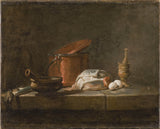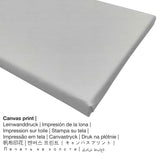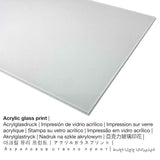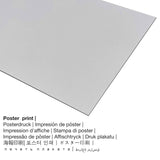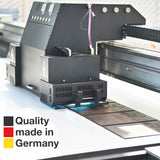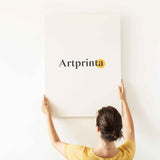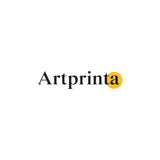Jean-Baptiste-Simeon Chardin, 1734 - Ndụ ka nwere arịa kichin na akwụkwọ nri - mbipụta nka mara mma.
Ụtụ gụnyere. Mbupu gbakọrọ na ndenye ọpụpụ.
Onyinye ngwaahịa
Ihe osise a na-akpọ Still Life with Kitchen Utensils and Vegetables e sere ya Jean-Baptiste-Simeon Chardin in 1734. The masterpiece has the following size: Height: 33 cm (12,9 ″); Width: 48 cm (18,8 ″) Framed: Height: 47 cm (18,5 ″); Width: 55 cm (21,6 ″); Depth: 6 cm (2,3 ″) and was painted with the medium oil on canvas. Today, this piece of art can be viewed in in the art collection of Nationalmuseum Stockholm, which is Sweden's museum of art and design, a Swedish government authority with a mandatet o preserve cultural heritage and promote art, interest in art and knowledge of art. We are happy to reference that this public domain piece of art is being included with courtesy of Nationalmuseum Stockholm & Wikimedia Commons.: . Further, the alignment of the digital reproduction is landscape with a ratio of 1.2: 1, nke pụtara na ogologo bụ 20% ogologo karịa obosara. Jean-Baptiste-Siméon Chardin was a painter from France, whose art style can be classified as Baroque. The European painter lived for a total of 80 years, born in the year 1699 in Paris and passed away in 1779 in Paris.
Nkọwa ihe osise
| Aha nka: | "Still Life with Kitchen Utensils and Vegetables" |
| nhazi ọkwa: | sere |
| Okwu mkpokọta: | nka ochie |
| Narị afọ nka: | 18th narị afọ |
| Emepụtara na: | 1734 |
| Afọ nka: | karịa afọ 280 |
| Usoro izizi: | mmanụ na kwaaji |
| Nha izizi nka: | Ogologo: 33 cm (12,9 ″); Obosara: 48 cm (18,8 ″) Ekebere: Elu: 47 cm (18,5 ″); Obosara: 55 cm (21,6 ″); Omimi: 6 cm (2,3 ″) |
| Ụlọ ihe ngosi nka: | National Museum nke Stockholm |
| Ebe ngosi nka: | Stockholm, Obodo Stockholm, Sweden |
| website: | www.nationalmuseum.se |
| Akwụkwọ ikike nka: | ngalaba ọha |
| Site n'aka: | Nationalmuseum Stockholm na Wikimedia Commons |
Tebụl ozi omenkà
| Ihe nkiri: | Jean-Baptiste-Simeon Chardin |
| okike onye nka: | nwoke |
| Obodo onye nka: | French |
| Ọrụ: | onye na-ese ihe |
| Obodo onye nka: | France |
| Nkewa onye nka: | nna ukwu ochie |
| Ụdị nke onye na-ese ihe: | Baroque |
| Afọ ọnwụ: | 80 afọ |
| Amụrụ n'afọ: | 1699 |
| Ebe omuma: | Paris |
| Nwụrụ n'afọ: | 1779 |
| Nwuru na (ebe): | Paris |
Ngwa ngwaahịa ndị ahịa anyị nwere ike ịhọrọ
Anyị na-enye ihe dị iche iche dị iche iche na nha maka ngwaahịa ọ bụla. Ka ị kwekọọ n'ihe ị chọrọ nke ọma, ị nwere ike họrọ n'ime nhọrọ nhazi ngwaahịa ndị a:
- Aluminom dibond (ọkpụkpụ ọla): An Aluminium Dibond print is a material with an impressive effect of depth. The Aluminium Dibond Print is your excellent introduction to fine art prints with aluminum. For your Print On Aluminum Dibond, we print the artpiece right on the surface of the aluminum. The bright components of the original work of art shimmer with a silky gloss but without glow. The colors of the print are luminous, fine details are clear and crisp, and the print has a a matte look that you can literally feel.
- Mpempe akwụkwọ ederede (akwa akwa akwa): A poster is a printed canvas paper with a slightly rough surface texture. Please note, that depending on the size of the poster we add a white margin 2-6 cm round about the painting, which facilitates the framing with your custom frame.
- Mbipụta enyo acrylic: A glossy print on acrylic glass, which is often named as a UV print on plexiglass, changes the original work of art into gorgeous wall decoration. In addition to that, the acrylic glass art print makes a viable alternative to canvas or dibond art prints.
- Kwaaji: A UV printed canvas material mounted on a wood frame. It generates the distinctive look of three-dimensionality. Additionally, a canvas print produces a nice and positive atmosphere. The advantage of canvas prints is that they are relatively low in weight. This means, it is easy to hang your Canvas print without extra wall-mounts. Therefore, a canvas print is suited for all kinds of walls.
Nkọwa akụkọ ahaziri ahazi
| Bipụta ụdị ngwaahịa: | ọmarịcha nka |
| Usoro mmeputakwa: | dijitalụ mmeputakwa |
| Usoro mmepụta: | Mbipụta UV / dijitalụ |
| Production: | Germany |
| Stockdị ngwaahịa: | mmepụta ihe na-achọ |
| Ihe eji eme atụmatụ: | mgbidi mgbidi, ụlọ mmepụta nka nka |
| Ndozi onyonyo: | usoro odida obodo |
| Ụdị anya: | 1.2: 1 |
| Mmetụta nke akụkụ akụkụ: | ogologo bụ 20% ogologo karịa obosara |
| Nhọrọ akwa: | Mbipụta kwaaji, mbipụta enyo acrylic (nwere ezigbo mkpuchi iko), mbipụta ọla (aluminium dibond), mbipụta akwụkwọ mmado (akwụkwọ kwaaji) |
| Ọdịiche dị n'okirikiri akwa akwa akwa (akwa akwa): | 60x50cm - 24x20", 120x100cm - 47x39", 180x150cm - 71x59" |
| Acrylic glass print (nwere ezigbo mkpuchi iko) nhọrọ: | 60x50cm - 24x20", 120x100cm - 47x39", 180x150cm - 71x59" |
| Mpempe akwụkwọ mmado (akwụkwọ kwaaji) nha dị iche iche: | 60x50cm - 24x20", 120x100cm - 47x39" |
| Aluminium dibond ebipụta (ihe aluminium) dị iche iche: | 60x50cm - 24x20", 120x100cm - 47x39" |
| Igwe onyonyo: | mmeputakwa na-enweghị isi |
Ihe dị mkpa: We try what we can in order to describe the products as clearly as possible and to exhibit them visually. Although, the pigments of the printed materials and the imprint can diverge marginally from the presentation on the monitor. Depending on the screen settings and the nature of the surface, not all color pigments are printed as exactly as the digital version depicted here. Bearing in mind that all the art prints are printed and processed by hand, there may also be minor variations in the motif's exact position and the size.
© Nwebiisinka nke, Artprinta (www.artprinta.com)

